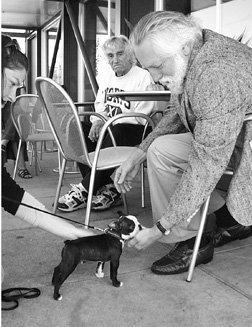I just completed a private consultation with a client whose under-socialized Australian Shepherd recently bit their 6-year-old daughter in the face, and nipped a friend of their 9-year-old son. I’m cursing a world that allows this to happen.
This well-meaning family adopted Blue from a shelter when he was 16 weeks old. He was “shy,” they said – he hid under a chair in the get-acquainted room when they met him. He had been at the shelter for two months – half his life. According to his paperwork he was the last of a litter of six and was timid when initially assessed.

In fact, all the pups were timid, but he was the worst – which was why he was the last one left when the Petersons went to the shelter to adopt last February. He was the only puppy in the shelter at the time, so they decided to take him despite his shyness. He’d come around, they thought, with love and attention.
Nature versus nurture
What they didn’t know was that at 16 weeks, Blue was reaching the end of a pup’s most important socialization period – the time in his life when he learns what is safe and good, and what is scary. In the wild, the lessons learned during the first few months of a pup’s life are critical to his survival. As he ventures out of his den he learns to be bold where it counts – pouncing on prey, for example – and cautious where prudent. Pups who don’t learn to avoid poisonous snakes, rushing floodwaters, and precipitous cliffs don’t live to pass on their genes!
During this period, puppies who live with humans need to learn that the world is a good and safe place. Their general assumption then becomes that people and other animals, places, and things are okay unless proven otherwise.
In contrast, puppies who are not socialized tend to be suspicious of everything except for a very narrow range of experiences they encounter in their very limited environment – a basement or backyard, for example. The rest of the world terrifies them, and any positive exposures they get later in life must struggle against this early, very strong programming.
A genetically sound pup has a better chance of recovering, at least to some degree, from a poor start in life. A pup who inherited poor genes for temperament and wasn’t well socialized early is often a lost cause – or, at least, a huge challenge for someone who is well-prepared, educated, and equipped to deal with him or her.
The fact that Blue and all his siblings were deemed to be “shy” when they were dropped off at the shelter indicated that they hadn’t received adequate early socialization. Most shelters aren’t ideal environments for remedial socialization, so by the time Blue was finally adopted, he was woefully behind in his “life is good” lessons – the lessons that, once missed, are very difficult (if not impossible) to make up.
The Petersons also didn’t know that if they wanted to try to make up for lost time they had to immediately start super-socializing their new pup. By the time they brought Blue to me he was 11 months old, and the prognosis for successful behavior modification was dismal.
This dog’s future is unknown. The Petersons want to try, and I will certainly try to help them, but they are facing a huge challenge. When children are involved and at risk, the tolerance for error is low and rightly so. I’m hoping to be pleasantly surprised by the outcome of this case.
Every dog is a product of the influence of his genes and his environment. If a pup comes from parents who have very genetically sound temperaments, then the pup can get by with an average amount of socialization – or even less. However, if Mom and Pop are genetically unstable, Pup needs to be ultra-socialized if he is to become a safe and friendly member of society.
The problem is, it’s pretty hard to tell the difference. If you adopt a pup from a shelter, you rarely get to meet the parents. Even if you buy from a breeder, you can’t tell if Mom and Dad are friendly because they’re genetically sound or because they were exceptionally well socialized. How do you know whether to give your new pup average socialization or the ultra package? You don’t.
The answer to this conundrum is to socialize the heck out of every single puppy. Then you don’t risk finding out later that you had a pup who needed an extra boost in the social department – you already gave it to him!
Early socialization
The best socialization programs begin while pups are still with their dams. A good breeder begins handling her pups gently and early, just as their eyes begin to open, giving them a positive association with human touch. As they get a little older (5-6 weeks) they should start meeting more humans – all shapes, colors, ages, and sizes – who feed them treats and pet them gently. The breeder will need to supervise these interactions closely, as rough handling at this stage can have the opposite effect, teaching the pups that humans aren’t safe to be around.
The mother dog’s attitude is important at this stage, too. If she is aggressive toward humans, or even just stressed about her pups being handled, the pups can register her attitude and learn this inappropriate behavior. If Mom is calm and relaxed around humans, pups are more likely to be, too.
By the time a pup is weaned at 7-8 weeks, he should already have a positive worldview programmed into his little puppy brain. When you select your pup from a litter, whether you’re at a breeder’s home or a shelter – or picking one from a box of free puppies on a street corner – choose wisely. Resist the temptation to rescue the pup who hides in the corner. Select, instead, the pup who is outgoing without being overbearing – the one who seems to have a cheerful, “Life is good!” attitude. Otherwise you risk finding yourself in the Peterson’s shoes, with an 11-month-old dog who is biting children in the face.
Okay, you’ve adopted a friendly pup with a sound temperament. Good for you! That doesn’t mean your job is done, however. You must continue your pup’s socialization lessons assiduously until he is 16 weeks old, and then maintain his positive association to the world throughout his life. If you take an 8-week-old well-socialized pup and stick him in your backyard with no outside exposure, the odds are good that you will end up with a problem.
The health dilemma
Puppy owners are often counseled by their veterinarians to keep their baby dogs cloistered safely at home until they are fully immunized at age 4-6 months. Looking at the situation purely from a physical health perspective, this makes good sense. You certainly don’t want to risk exposing your pup to nasty distemper or parvo bugs.
From a mental health perspective, however, it’s horrible advice. You only have two to three more months to give your pup an unshakable faith in the goodness of the world. You cannot afford to wait until those shots are done. During this period, you want to give your pup at least 100 new positive exposures and experiences, to “vaccinate” him against the possibility that he will feel compelled to bite someone, someday (see “100 Exposures In 100 Days” sidebar). It’s not a guarantee against biting, but it’s by far your best chance of ending up with an adult dog who is friendly and safe.
Fear periods
At one time in the last several decades, much ado was made about a pup’s “critical fear periods.” Behaviorists attempted to pinpoint those periods of time in puppyhood during which a “bad experience” would scar a pup’s psyche for life. More recently, we have come to realize that, although pups do seem to go through periods during which they are more fearful than others, that time can vary from one pup to the next. Rather than wrapping your pup in cotton wool for a designated period, it makes more sense to watch him closely and ensure that he has mostly good experiences, especially if he seems to be going through a cautious stage.
Even if something does frighten him, it’s not the end of the world – you can set up a counter-conditioning and desensitization (CC&D) program to restore a positive association with that particular stimulus, and your pup should recover nicely.
Lifetime socialization
Now your pup is 16 weeks old. You’ve reached the end of that magic socialization window, your “100 exposures” list is all checked off, and your pup loves the world. Are you done? Hardly.
Like your training efforts, which continue on into adulthood and throughout your dog’s entire life, you are never done with socialization. You’ve laid a very solid foundation; that’s something to be proud of.
Much of that will be lost, however, if you toss your four-month-old pup into the backyard and cease all exposure. He still needs to meet and greet people, go places with you, and continue to share your world and your experiences, if you want him to continue to be the happy, friendly puppy he is today. And, of course, that’s what you want!
-Pat Miller, CPDT, is WDJ’s Training Editor. She is also author of “The Power of Positive Dog Training,” and “Positive Perspectives: Love Your Dog, Train Your Dog.”





